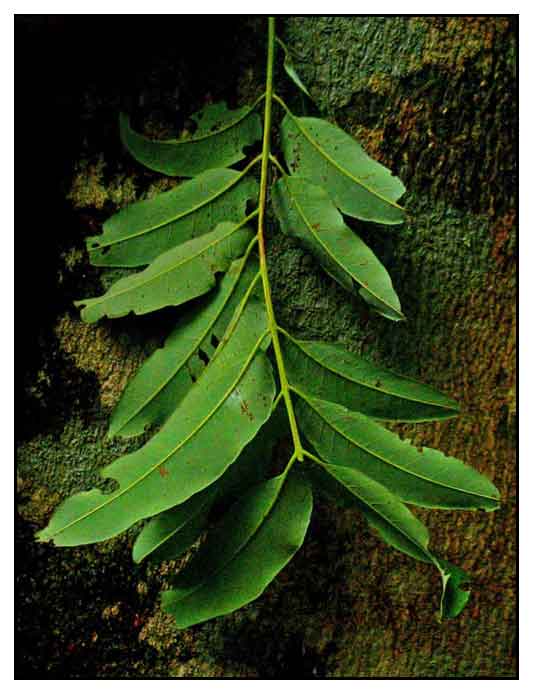 Botany Botany
Abuab is a tree growing to a height of 25 to 50 meters. Leaves are opposite or occasionally alternate, smooth, oblong, often 15 to 18 centimeters long but sometimes reaching a length of 25 centimeters, about 7 centimeters wide, and usually pointed at both ends. Flowers are greenish white, about 1 centimeter in diameter, with five petals, and borne in terminal or axillary panicles. Fruit is leathery and smooth, reaching a 12 centimeters long and 2.5 centimeters wide, with three, broad, longitudinal wings.
Distribution
- In primary forests at low and medium altitudes up to 1000 meters, in Rizal, Quezon, Laguna, and Camarines Provinces in Luzon; in Mindoro, Masbate, Leyte Mindanao, and the Sulu Archipelago.
- Also reported in Thailand, Vietnam, Peninsular Malaysia, Sumatra, Java, Borneo, Celebes, Moluccas and New Guinea.
Constituents
- Plant yields a physiologically active substance, a saponin which in poisonous in small quantities. (10)
- Study isolated a glucoside, lophopetalin.
- Study yielded lophopetalin, 0.2%; saponin; phytosterine, 5%; luperol; betulin; and a new stearin.
- Phytochemical screening of leaves yielded flavonoids, steroids, tannins, and triterpenoids (see study below) (8)
- Studies on the bark have yielded the known k-Strophanthidin (1), Antiarigenin (6) and β-Antiarin (Antiarigenin-3-β-O-α-l-rhamnoside (10), mono- and diglycosides were identified, viz. strophanthidin-3-β-O-α-6-desoxy-d-allopyranoside (strophalloside, 2), strophanthidin-3-β-O-β-6-desoxy-d-glucopyranoside (= Strophanthidin chinovoside, 3), strophanthidin-3-β-O[-4Oβ-d-allopyranosyl-β-6-desoxy-d-allopyranoside] (4), strophanthidin-3-β-O-[3-O-β-d-glucopyranosyl-β-6-desoxy-d-talopyranoside] (5), antiarigenin-3-β-O-[3-O-β-d-gulopyranosyl-β-6-desoxy-d-talopyranoside] (7), antiarigenin-3-β-O-[4O-β-d-allopyranosyl-β-6-desoxy-d-allopyranoside] (8), and antiarigenin-3-β-O-β-6-desoxy-d-allopyranoside (antiallosid) (9). (see study below) (6)
Properties
- Studies have shown antimicrobial, free radical scavenging, thrombolytic, membrane stabilizing, cytotoxic and positive inotropic activities.
Parts used
Bark sap.
Uses
Folkloric
- In the Philippines, thickened sap of the bark used by the Negritos and other hillmen to poison the tips of their arrows or darts.
Others
- Wood: Timber used for light construction, furniture, plywood and panelling.
- Poison: Bark used as constituent of dart poison.
Studies
• The studies are from L. toxicum and the synonyms in Quisumbing's compilation, many of which are unresolved names.
• Cardiac glycosides / Arrow Poison: A combined analytic method is described for the identification of eight 6-deoxyhexoses of cardiac glycosides found in the arrow poison of LT.
• Phytochemical screening / Bark: Study isolated a crystalline substance from the bark of LT. Preliminary tests yielded saponin, terpenoids, and steroids. Petroleum ether and ether extract isolated a triterpenoid compound. (3)
• Free Radical Scavenging / Membrane Stabilizing Potential: Study evaluated a crude methanolic extract of leaf of Lophopetalum fimbriatum and C. inophyllum as well as their fractions for biological activities. isolated a crystalline subs compound. A methanolic crude extract showed the highest free radical scavenging activity which could be correlated with total phenolic contents. L. fimbriatum showed lysis in the assay thrombolytic activity, inhibition of human erythrocyte hemolysis. Results showed radical scavenging activity and significant cytotoxic and membrane stabilizing potentials. (5)
• Cardiac Glycosides / Cytotoxic and Inotropic / Bark: Study of the cytotoxic and positive inotropic acting bark extract yielded eight cardiac glycosides. Besides the known k-strophanthidin, antiarigenin and β-Antiarin, mono- and diglycosides were also identified. (see constituents above) (6)
• In-Vitro Membrane Stabilizing / Thrombolytic: Study evaluated different extracts of Lophopetalum javanicum leaves for erythrocyte membrane stabilizing and thrombolytic activities. Results showed strong membrane stabilizing activity compared to acetylsalicylic acid. Fractions showed strong thrombolytic activity in human blood specimen. Phytochemical screening yielded flavonoids, steroids, tannins, and triterpenoids as major constituents which may be responsible for the biologic effects. (8)
• Free Radical Scavenging / Thrombolytic Activity / Antimicrobial: Study of Lophopetalum fimbriatum and Calophyllum inophyllum extracts showed high free radical scavenging activity which could be related to total phenolic contents. In assay for thrombolytic activity, the carbon tetrachloride soluble materials of L. fimbriatum revealed clot lysis by 8.89 ± 1.410%. The antimicrobial activity of a chloroform soluble fraction of L. fimbriatum demonstrated 16.0 mm zone of inhibition against Sarcina lutea. (9)
Availability
Wild-crafted.
|

![]()




